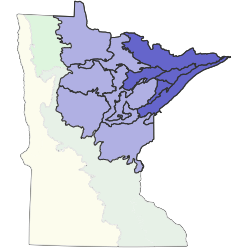The Northern Superior Uplands Section (NSU) largely coincides with the extent of the Canadian Shield in Minnesota. The NSU is characterized by glacially scoured bedrock terrain with thin and discontinuous deposits of coarse loamy till and numerous lakes. The section has high relief, reflecting the rugged topography of the underlying bedrock. the NSU receives more of its precipitation as snow than any section in the state, has the longest period of snow cover, and the shortest growing season.The upland vegetation is remarkably uniform relative to that of other sections in the LMF Province, consisting mostly of fire-dependent forests and woodlands. Forests with red and white pine were widespread in the past, mixed with aspen, paper birch, spruce, and balsam fir; much of the pine was cut in the late 1800s and early 1900s, leaving forests dominated mostly by aspen and paper birch. Jack pine forests are present on droughty ridges and bedrock exposures, as well as on local sandy outwash deposits.The highlands along Lake Superior have a local climate moderated by the lake that favors forests dominated by sugar maple with some white pine, yellow birch and white cedar. Peatlands and wet forests are present across the section as inclusions within broader upland forest areas; sparsely vegetated cliffs and bedrock outcrops are common in the rugged terrain along Lake Superior and in the border lakes region of the northern part of the section.

Subsections are units within Sections that are defined using glacial deposition processes, surface bedrock formations, local climate, topographic relief, and the distribution of plants, especially trees. Minnesota has 26 subsections. Printable map of subsections


